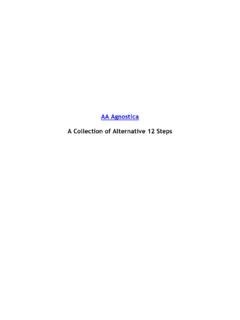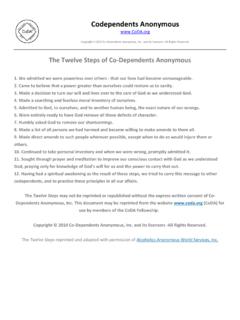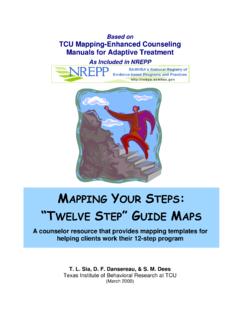Transcription of 12 Traditions Study - Just Love Audio
1 Traditions Study Guide 2 3 Week 1 - Traditions History Before I start, it s important to say that no member speaks for AA. No one has been elected or appointed to do so. So all I m going to do tonight is share my experience, strength and hope with the Traditions . Most of that has been given to me from the generosity of other AA members and from AA literature. I ll refer often to AA literature and cite it. That s not for your benefit it s for mine to keep me honest and focused. I do have a love for AA history and that will be part of the discussions as well. Tonight I m going to focus on the origin of the Traditions . What caused them to happen and what is their purpose?
2 How did they evolve? I ll cover their history up to 1988. The story of the Traditions is a fascinating one. There is more written about the Traditions in AA literature than there is about the Steps. However, one of the challenges of our history literature is that it is not organized in a timeline or chronological order that shows how the Traditions , and many other things, originated and evolved over time. So for tonight I d like to discuss that type of timeline of how the Traditions originated and evolved. In the book AA Comes of Age, Bill W described the Traditions with 3 short but solid paragraphs: 1. Implicit throughout AA s Traditions is the confession that our fellowship has its sins. We confess that we have character defects as a society and that these defects threaten us continually.
3 Our Traditions are a guide to better ways of working and living, and they are also an antidote for our various maladies. the 12 Traditions are to group survival and harmony what AA s 12 steps are to each member s sobriety and peace of mind. 2. But the 12 Traditions also point straight at many of our individual defects. By implication they ask each of us to lay aside pride and resentment. They ask for personal as well as group sacrifice. They ask us never to use the AA name in any quest for personal power or distinction or money. The Traditions guarantee the equality of all members and the independence of all groups. They show how we may best relate ourselves to each other and to the world outside.
4 They indicate how we can best function in harmony as a great whole. 3. For the sake of the welfare of our entire society, the Traditions ask that every individual and every group and every area in AA shall lay aside all desires, ambitions, and untoward actions that could bring serious division among us or lose for us the confidence of the world at large. the 12 Traditions of Alcoholics Anonymous symbolize the sacrificial character of our life together and they are the greatest force for unity that we know. As part of AA s 3 Legacies of Recovery, Unity and Service, the Traditions are the spiritual principles whose objective is the promotion of unity within our Fellowship. It s important to emphasize the fact that the Traditions are not some legal code to use to point fingers at other members and accuse them of violating this or violating that.
5 It is not the intent of the Traditions to seek lock- step conformity - the intent of the Traditions is to seek spiritual unity. There is an old truism that suggests that groups are not destroyed from the outside - they are 4destroyed from the inside. Sadly this all too true on issues that cause divisiveness within a group. The Traditions teach us how to be unifiers - not dividers. Hindsight is 20/20 and history is hindsight, particularly in searching for causes and effects. In terms of cause and effect, the formal documentation of AA Traditions actually began in April 1939 with the publication of the Big Book. They weren t called the Traditions then but the foreword to the 1st edition of the Big Book contains many, but certainly not all, of the spiritual principles in our 12 Traditions .
6 I m going to get into the Foreword in more detail later on. First though I d like to offer an example of why the Traditions are so important. There was a fellowship, actually a temperance society that came into existence almost a century before AA started. It was originally very much like AA in its purpose and membership. Unfortunately, after an initial period of meteoric growth, it failed and faded away for lack of the equivalent of AA s Traditions . This fellowship began in April 1840, when 6 drinking friends in Baltimore, MD formed the Washington Temperance Society. They later became known as the Washingtonians. They required a pledge of abstinence and attendance at weekly meetings where members would tell their stories of drunkenness and recovery.
7 As a body, they recognized no religion and were politically neutral. Each member was supposed to seek out and help other alcoholics who were still drinking. Does that sound familiar? However, over a relatively short period of time, Washingtonian membership changed radically to consist mainly of non-alcoholic temperance advocates and a large number of adolescents under age 15. The total Washingtonian membership rose to several hundred thousand but the number of alcoholics in the mix was likely well under 150,000. The only requirement for Washingtonian membership was to sign a pledge card to abstain from alcohol. As their membership grew to consist mainly of non-alcoholics, sentiments shifted away from helping alcoholics to pursuing a legal means of prohibiting alcohol.
8 The temperance movement in the country was changing into the prohibition movement. The rapid growth of Washingtonians was extraordinary. However, their downfall came about 7 years after they started. Early Washingtonian practices came to be viewed as outmoded and interest in them declined. There was no sudden or massive collapse, they just faded away over time. Almost none of the Washingtonian societies were active beyond 1847. Some claim that involvement in religion, politics and abolition of slavery led to the Washingtonian s downfall. While there were cases of this, there is no compelling evidence to conclude that these issues really played a major role in the downfall of the Washingtonians. Prohibition was certainly a very divisive issue among the Washingtonians.
9 However, the major causes of their downfall appear to be a direct result of their departing from their original membership makeup (which started out as all alcoholics) and departing from their original primary purpose (which started out as one alcoholic helping another alcoholic). It s a powerful, powerful lesson on the importance of AA s Traditions and Legacy of Unity. 5 Almost a century after the Washingtonians began and then faded away, AA started in Akron, OH with our 2 co-founders, Bill W and Dr Bob, in June 1935. The 4th of July is important in our nation s history - it s Independence Day. The 4th of July is also important in AA history. AA s 1st group, Akron #1, marks its beginning as July 4, 1935 when Bill D, who was AA #3, was discharged from Akron City Hospital and joined with Bill and Dr Bob to help other alcoholics.
10 In the autumn of 1935 there were only 2 groups 1 in Akron and 1 in NY. By the end of 1936 there were a total of 15 members. By the end of 1937 that rose to a total of 40 members. In 1938 that rose to 65 members. When the Big Book was published in April 1939 there were still only 2 groups and the membership was around 100. By comparison, my home group today has 200 names on our group phone list. That s twice the size of the entire AA membership that existed when the Big Book was published in the spring of 1939. Principle of Group Conscience - December 1936 In AA Comes of Age the earliest personal experience that involved Bill W, and influenced the Traditions , occurred when Bill was 2 years sober. In December 1936, Charles B Towns offered Bill W a lucrative job at his hospital as a lay alcoholism therapist.









